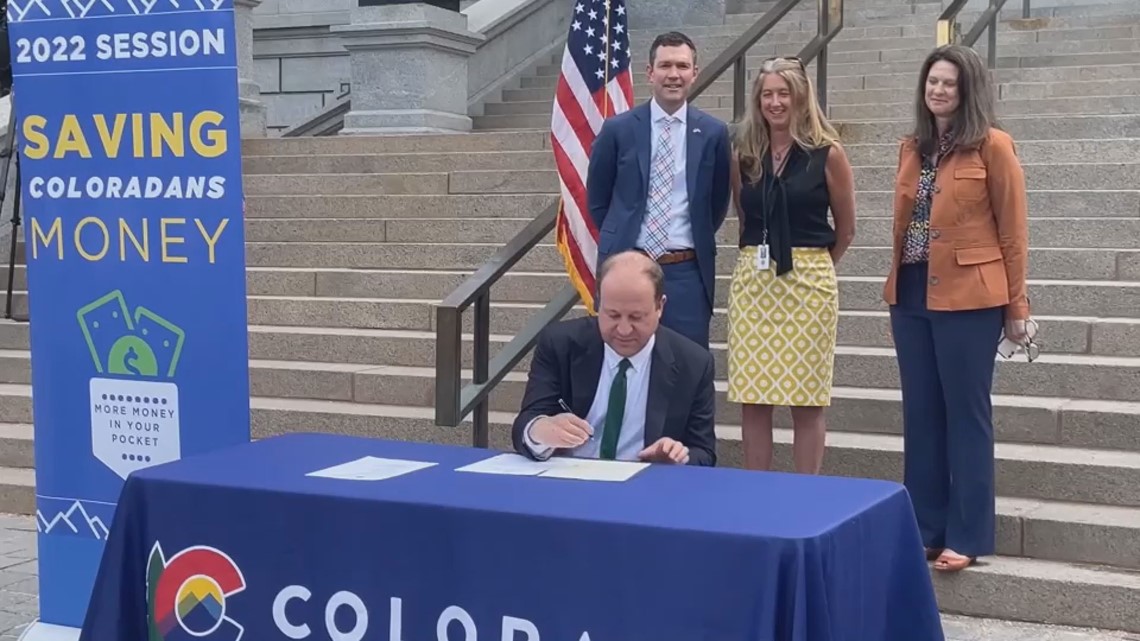DENVER — Speeding is still speeding if you're five miles over the speed limit or 15. You are just choosing to speed a little bit slower.
The same concept can be used to describe a property tax bill just signed into law in Colorado.
You will hear lawmakers call it a property tax cut. But that does not mean your property tax bill is going down. It is likely going up, just a little bit slower.
Gov. Jared Polis (D) signed into law today Senate Bill 22-238, which makes two years of changes to the collection of property taxes.
It was signed into law next to a banner that said: "Saving Coloradans Money."
"Saving Coloradans Money" is different than Coloradans paying less than they pay not.
The bill does not mean your property tax payment will go down.


"The terminology works because essentially what we’ve done is really to try to get rid of the spike that would be happening in property taxes if we hadn’t made this change," said State Sen. Chris Hansen (D-Denver). "The number on the piece of paper will go up, I think we need to be honest about that, but it’s going to go up a lot less than it would have, and I think that’s the important message."
Two of the bill's sponsors are an unlikely pair: Hansen and State Rep. Patrick Neville (R-Castle Rock).
"Look, it's probably not a surprise to anyone that I hate taxes, but the worst kind of taxes are property taxes, where you are literally paying the government rent on something that you bought that they didn't help you pay for," said Neville.
The complicated part of the property tax bill is pretty much the entire bill because it requires understanding the calculations that determine property taxes.
In 2023, property taxpayers bills will reflect the property values from 2022.
When you get your bill next year, single family homeowners will pay a residential assessment rate of 6.95%.
For a home with a county assessed value of $500,000, that number is multiplied by 6.95% to get the taxable value, which is then multiplied by the specific mill levies (school district, city, county, fire, water, parks, etc.) in your county.
For the tax bill you pay in 2024, it will be based on your property value in 2023. Every two years, counties reassess property values. So what you pay in 2024 will be based on your property value in 2023, which is based on sales and values from January 2021 through June 2022.
Clear as mud, we know.
Taking that $500,000 single family home example, follow the math for a property tax calculation in 2024.
Let's say the county reassesses your home value higher to about $550,000 (it could be more or less). First, to combat the increase, the bill takes $15,000 off the top and makes it tax-free. Second, the residential assessment rate reduces to 6.765%. So the calculation to determine your property's taxable value looks like this: $535,000 multiplied by 6.765%. That number is then multiplied by the specific mill levies in your county. In this example, based on the state's mill levy average, would pay about $123 more in property taxes, even with the lower assessment rate and the tax-free $15,000. Without those calculation changes, the property tax bill would be $290 higher.
"For counties, property tax is our primary revenue stream," said Gini Pingenot, director of external affairs for Colorado Counties, Inc., an association of elected county commissioners.
She points out that uncertainty exists because estimating property values in the future is just that -- estimating.
"It's off by a year which makes it sometimes complicated," said Pingenot.
Property taxes pay for a variety of county services.
"Public health services. Counties are also responsible for running elections. We maintain thousands of miles of roads and bridges," said Pingenot.
She said key drivers for county costs are:
- Employee salaries and benefits
- Petroleum from county fleets, fuel needs and construction
- Remodeling/rebuilding public assets (rec centers, jails, justice centers)
"Many communities and local governments are having to make midterm adjustments to their budget just to retain the workers they already have and not lose them, and they have a lot of vacancies," said Pingenot.
The state plans to backfill most of the money that counties do not get because of the property tax changes.
The new law also saves nonresidential property owners by reducing the assessment rate for businesses, the first time that has happened in four decades.
Over two years, the law intends to save property taxpayers $700 million collectively.
The second year (the property tax bill you pay in 2025) assessment rate will be calculated depending on how much is saved by taxpayers in 2024. And remember, "saved" means you likely paid more, just not as much as you would have without the new law.
*Editor's note: A previous version of this story stated that the property tax increase for the $500,000 home becoming a $550,000 home would be $1,400. That is the difference in taxable value, not the property tax bill.
SUGGESTED VIDEOS: Full Episodes of Next with Kyle Clark

